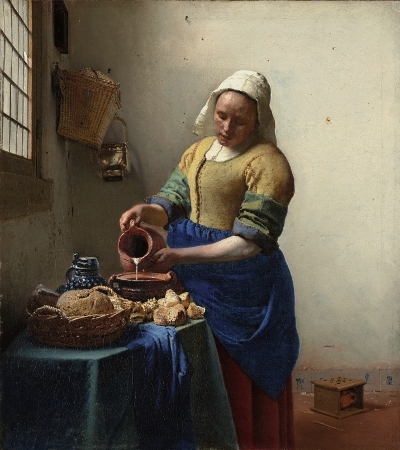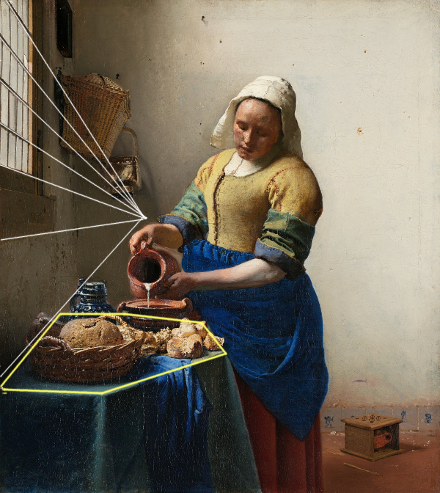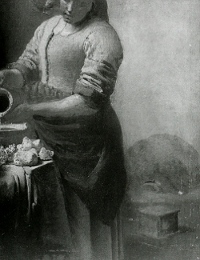A piece of art is not only a mere painting in which certain imagery is represented. It is also a way of representing reality, capturing the painter’s personality in every brushstroke and even, reflecting the mentality and concerns of a particular period. Therefore, as a means of understanding both, the artist and the painting and what is beyond it, I am going to dig deep into this particular piece of art and scrutinize its hidden mysteries and motives.
The Milkmaid is an oil on canvas painting of 45.5 x 41 cm by the famous Dutch painter Johannes Vermeer. In it the artist captures, with great detail and accurateness I must say, the frugality and determination with which a domestic kitchen maid performs one of her most ordinary duties: the pouring of milk into a stoneware. The picture is held in the Rijksmuseum in Amsterdam, Netherlands. Although the exact year of the painting’s completion is unknown, experts determine that it was painted between the years 1657-1661.

“The Milkmaid” was painted in a time of great wealth and power in the Netherlands, in which trade, art and science developed so much as to be among the most acclaimed in the world. In 1568 The Seven Provinces that signed the Union of Utretcht started a rebellion against Phillip II of Spain which eventually led to the Eighty Years’ War. Before Spain started to reconquer the Low Countries again, England declared war to Spain, thus, forcing the Spanish troops to halt their advances. The Eighty Years’ War finally ended with The Peace of Westphalia in 1648, where the peace settlement was signed by Spain and the Republic of the Seven United Netherlands. The Dutch East India Company settled a Dutch monopoly on Asian trade which prevailed for two centuries. The Dutch also dominated the trade between European countries, by the year 1680 an average of nearly 1000 Dutch ships crossed the Baltic Sea each year.
As far as social status is concerned, the Netherlands’ one was largely determined by income. This brought a brand new way of looking at social classes. Aristocracy had sold out most of its privileges to cities, where merchants and their money were dominant. The clergy did not have influence since the Roman Catholic Church had been suppressed in the onset of the Eighty Years’ War. Calvinism was the predominant religious movement of the time, and there are some rumors which connect Vermeer with Calvinist beliefs although it is not clear whether he became a Catholic after marrying his wife. As the article of the Wikipedia points out:
“ In 1653 Johannes Reijniersz Vermeer married a Catholic girl named Catharina Bolnes. The blessing took place in a nearby and quiet village Schipluiden. For the groom it was a good match. His mother-in-law, Maria Thins, was significantly wealthier than he, and it was probably she who insisted Vermeer convert to Catholicism before the marriage on 5 April. Some scholars doubt that Vermeer became Catholic, but one of his paintings, The Allegory of Catholic Faith, made between 1670 and 1672, reflects the belief in the Eucharist. Liedtke suggests it was made for a Catholic patron, or for a schuilkerk, a hidden church.” Read information in context. (Retrieved from Wikipedia, 04/25/2010 12:25 A.M.)
Due to the strong doctrines of Calvinism, the artists of the time were not allowed to depicted sex in their paintings. However, Vermeer, along with other artist of the time, knew how to circumvent the censors by leaving subtle symbols that evoke lust or female sexuality. The pouring of milk might have lascivious connotations, the Dutch word for milk “melken” might also be defined as “to sexually attract”. The Deft tile in the frieze of the wall behind the milkmaid depicts Cupid: a symbol of love and sexual attraction. At this point, the capricious viewer may turn its attention to the foot warmer on the floor. The coals gathered inside it might as well symbolize the warmth of lust or the hidden burning passion of a woman for her beloved. The milkmaid’s body becomes eventually the center of attraction. It was not only the thickness of her waist that attracted the viewer of the time, but also the contrast between the rough leather sleeves with the fleshy nudity of her exposed forearm. It seems that Vermeer was well acquainted with the reputation of milkmaids, who were known for their sexual availability. In the end, it is not only the allusions to female sexuality, but also the depiction of an honest and hard working milkmaid that give the picture its romantic or emotional meaning.
To achieve this level of precision, Vermeer used a sophisticated painting technique which was developed and enhanced throughout his life. However, it is not easy to recreate or determine the way Vermeer painted for he constantly experimented with different techniques. At first, in his early works he used a thick impasto paint layer, technique later used by Van Gogh. The color used in the paintings was intense but the lighting in fact tended to be conventional. By using this technique Vermeer puts an emphasis to the materials present in the picture rather than in the characters portrayed. Later he started working with a new technique called “pointillé”, or little dots of paint applied to a canvas in order to obtain a higher level accuracy and detail. Although it is not very clear, some experts maintain that the use of this specific technique along with other visual peculiarities, suggest that Vermeer might have used the “camera obscura”, a precursor to the modern photographic camera, in some of his works.
Throughout his maturity works Vermeer is identified by the subtle variation in the tonal values rather using the radical and forceful “chiaroscuro”. In paintings like The Milkmaid paint is applied with the utmost economy, his brushstrokes being judicious and almost calligraphic. The objects and human figures are carefully portrayed and in some areas paint has been applied so thinly that, if one looks at the picture closely, the underlying layers can be seen. Many experts believe that this might have been due to not finishing his paintings completely, however, these are only speculations.
 Lest we forget, Vermeer used a few number of pigments if compared to his contemporary color producer and painter Rembrandt who used more than a hundred pigments. However, less than twenty pigments have been detected in Vermeer’s works and ten of those seem to have been of regular usage. As an interesting fact, in Vermeer’s time each pigment was differed from the other in terms of permanence, drying time and workability. The difficulty of painting with these pigments was that many of those were often not compatible with each other and had to be used separately. Although it is unlikely that Vermeer had every pigment in his palette when creating one of his works, it is possible that he had the pigments needed for each part of the painting he was working at. Vermeer commonly employed seven different types: white lead, yellow ochre, vermillion, red madder, green earth, raw umber and ivory black. A remarkable fact would be to say that in order to paint bluish tones in The Milkmaid; Vermeer used a special pigment called ultramarine, which was more expensive and finer than the commonly used azurite.
Lest we forget, Vermeer used a few number of pigments if compared to his contemporary color producer and painter Rembrandt who used more than a hundred pigments. However, less than twenty pigments have been detected in Vermeer’s works and ten of those seem to have been of regular usage. As an interesting fact, in Vermeer’s time each pigment was differed from the other in terms of permanence, drying time and workability. The difficulty of painting with these pigments was that many of those were often not compatible with each other and had to be used separately. Although it is unlikely that Vermeer had every pigment in his palette when creating one of his works, it is possible that he had the pigments needed for each part of the painting he was working at. Vermeer commonly employed seven different types: white lead, yellow ochre, vermillion, red madder, green earth, raw umber and ivory black. A remarkable fact would be to say that in order to paint bluish tones in The Milkmaid; Vermeer used a special pigment called ultramarine, which was more expensive and finer than the commonly used azurite.
Using the painting as the center to my analysis, I am going to frame the most important parts of it and analyze them separately (see picture above). Taking the face of the milkmaid as a starting point, it is important to focus on the light coming from the window and reflecting directly upon her face in shadows and pale scales therefore, creating an effect of three-dimensionality. For the face Vermeer used small touches of paint like reddish brown, white, light ocher and brown combined all together in order to paint the shape of her face. The window becomes one of the central themes of the picture, providing the portrait with light and luminosity. Vermeer gives the utmost attention each and every detail in the painting; a common object like the rustic window is meticulously painted paying attention to little details like a broken piece of glass or the irregularity of the window frame. In his later works, as the Essential Vermeer webpage puts it, “the windows become so geometrically stylized that in some cases they seem abstract works of art in themselves”. ( Retrieved from Essential Vermeer, 04/27/2010, 23:15 P.M.)
The basket and the copper pail next to the window are both elements related to the thematic of the painting: the pouring milk. Both being objects used when shopping in the market. The basket is painted using the white, ochre and black, which eventually mingle to adapt to the form of the basket’s wicker. This leads me to the idea that Vermeer also used the three previously mentioned colors repeatedly in the painting. It is likely that he turned his attention to every detail, deliberately placing the objects and choosing the milkmaid’s dressing according to a certain color spectrum and texture pattern. The milkmaid’s dress is said to be a winter dress due to the amount of layers it has. She wears a robust chamois leather top and a blue apron over a heavy red wool skirt. Taking a close look at the milkmaid’s garment one can see that it was painted applying thick and quick dabs of yellow and brown pigments to give it the rough texture required.
The vessel, the irregular shaped jar, the pieces of bread on the table and the extreme care with which pours the milk are elements that give great meaning to the final composition. These elements suggest that the woman was making bread pudding; this might be a possible reason to explain why the milkmaid is pouring the milk with such care. One possibility could be to take the right measures for the recipe, the other might be to avoid dropping the skin formed on top of the milk into the stoneware thus spoiling the recipe. The slightly porous texture of the stoneware and the “pointillés” used for painting the bread, give the picture an extraordinary luminosity and lifelikeness.
Having covered almost all the upper part of the picture I am going to center my analysis on the lower. The decorated tiles in the lower part of the wall behind the milkmaid, served as a skirting that protected the plaster from the daily damage of brooms and were made tiny works of art of the finest porcelain. On one of the tiles a Cupid can be appreciated which leads to two different schools of thought, one supporting the amorous interpretation of it and a more skeptical one, who believes that those Cupid were symbols often used in the Dutch houses of the time. The table painted in the “The Milkmaid” has been an object of controversy to many critics, while some believed that there was an anomaly in the cloth-covered table that the painter might have skipped, other supported the idea that the table might have not been rectangular in shape, but rather octagonal at its top (as seen in the picture bellow).

Finally, as a means of putting an end to this article I am going to include some of the curiosities I found on this particular painting. What concerns people the most, is the identity of the milkmaid, critics have speculated that it was Tanneke Everpoel, Vermer’s family maid. Through some archival documents of 1663 we know about her existence and character (For more information click here to go to the Essential Vermeer webpage and the click on the milkmaid’s face in the photo). It is largely known that many of Vermeer’s paintings, after having been exposed to X-rays, reveal some items which were painted over. The Milkmaid is not an exception; a clothes basket can be found near the bottom of the painting, behind the maid’s red skirt. As a matter of fact, the Milkmaid was the last painting by Vermeer that centered on a working class theme, thus, making it unique and everlasting.

